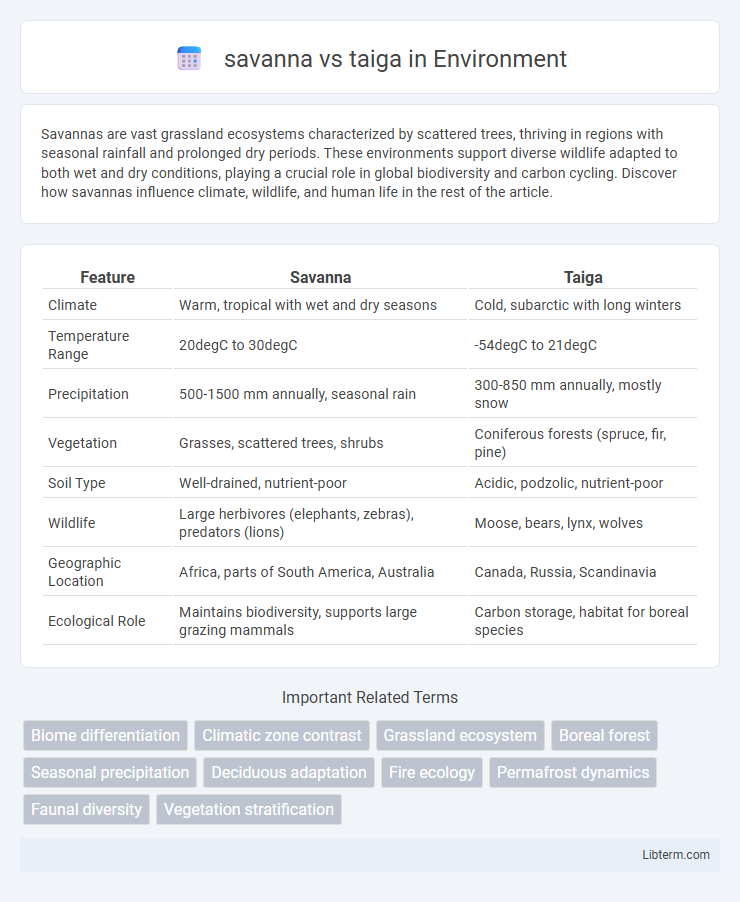Savannas are vast grassland ecosystems characterized by scattered trees, thriving in regions with seasonal rainfall and prolonged dry periods. These environments support diverse wildlife adapted to both wet and dry conditions, playing a crucial role in global biodiversity and carbon cycling. Discover how savannas influence climate, wildlife, and human life in the rest of the article.
Table of Comparison
| Feature | Savanna | Taiga |
|---|---|---|
| Climate | Warm, tropical with wet and dry seasons | Cold, subarctic with long winters |
| Temperature Range | 20degC to 30degC | -54degC to 21degC |
| Precipitation | 500-1500 mm annually, seasonal rain | 300-850 mm annually, mostly snow |
| Vegetation | Grasses, scattered trees, shrubs | Coniferous forests (spruce, fir, pine) |
| Soil Type | Well-drained, nutrient-poor | Acidic, podzolic, nutrient-poor |
| Wildlife | Large herbivores (elephants, zebras), predators (lions) | Moose, bears, lynx, wolves |
| Geographic Location | Africa, parts of South America, Australia | Canada, Russia, Scandinavia |
| Ecological Role | Maintains biodiversity, supports large grazing mammals | Carbon storage, habitat for boreal species |
Introduction to Savanna and Taiga
Savannas are tropical grasslands characterized by scattered trees, warm temperatures, and distinct wet and dry seasons, supporting diverse wildlife like elephants and lions. The taiga, or boreal forest, is a vast biome dominated by coniferous trees such as spruce and fir, with cold climates and long winters, home to species like moose and lynx. Both biomes play crucial roles in global ecosystems, influencing carbon storage and climate regulation.
Geographic Distribution and Climate
Savannas are predominantly found in regions of Africa, South America, and Australia, characterized by warm temperatures year-round and a distinct wet and dry season. Taigas, or boreal forests, are located across the high northern latitudes of North America, Europe, and Asia, experiencing cold, lengthy winters and short, mild summers. The geographic distribution of savannas aligns with tropical and subtropical zones, while taigas thrive in subarctic climates, influencing their vegetation and wildlife adaptations.
Soil Characteristics
Savanna soils are typically nutrient-poor, acidic, and well-drained with a high content of iron and aluminum oxides, often classified as Ferralsols or Acrisols, which support grasses and scattered trees adapted to periodic droughts and fires. In contrast, taiga soils, primarily Spodosols, are acidic, podzolized, and characterized by a significant accumulation of organic matter in the upper layers due to slow decomposition rates under cold temperatures, resulting in nutrient-poor conditions that support coniferous forests. The distinct soil compositions reflect adaptations to their respective climates, with savanna soils favoring drought-resistant vegetation and taiga soils supporting cold-tolerant conifers.
Flora Diversity and Adaptations
Savanna ecosystems feature diverse grasses and scattered trees like acacias, adapted to withstand seasonal drought and frequent fires through deep roots and fire-resistant bark. Taiga forests, dominated by coniferous species such as spruces, pines, and firs, exhibit adaptations like needle-shaped leaves and thick waxy coatings to reduce water loss and endure cold, snowy winters. Both biomes showcase flora evolved to survive harsh environmental conditions, but savanna plants prioritize drought and fire resilience, whereas taiga flora focus on cold tolerance and water conservation.
Fauna Diversity and Adaptations
Savanna ecosystems support a rich diversity of herbivores such as elephants, zebras, and antelopes, along with predators like lions and cheetahs that have adapted to the open grasslands with speed and camouflage. Taiga regions, dominated by coniferous forests, host species like moose, lynxes, and wolves, which possess thick fur and behaviors suited for cold, snowy environments. Fauna in both biomes exhibit specialized adaptations that enable survival in vastly different climates, from the savanna's seasonal droughts to the taiga's harsh winters.
Seasonal Patterns and Weather
Savannas experience distinct wet and dry seasons, with temperatures ranging from 20degC to 30degC and sporadic rainfall primarily during the wet season, supporting grasslands and scattered trees. Taigas have long, cold winters with temperatures often dropping below -30degC and short, mild summers, featuring moderate precipitation mostly as snow. These contrasting seasonal patterns influence the types of vegetation and animal adaptations unique to each biome.
Ecological Roles and Functions
Savannas support diverse herbivore populations that maintain grassland ecosystems through grazing, promoting nutrient cycling and preventing shrub encroachment. Taiga forests act as significant carbon sinks, with coniferous trees sequestering large amounts of CO2 and regulating global climate patterns. Both biomes provide critical habitats for specialized flora and fauna, sustaining biodiversity and ecological resilience in their respective regions.
Human Impact and Environmental Threats
Savannas face significant threats from deforestation, agricultural expansion, and uncontrolled wildfires, leading to habitat loss and reduced biodiversity. Taiga ecosystems are heavily impacted by logging, mining, and climate change, which cause permafrost thawing and increased vulnerability to pests and wildfires. Both biomes experience human disturbances that disrupt natural cycles, endangering wildlife and ecosystem stability.
Conservation Efforts and Challenges
Conservation efforts in savanna ecosystems prioritize fire management, anti-poaching measures, and habitat restoration to protect iconic species like elephants and lions. Taiga conservation focuses on sustainable logging practices, combating climate change impacts, and preserving biodiversity through protected areas in regions such as Siberia and Canada. Both biomes face challenges including habitat fragmentation, climate change, and human encroachment that threaten their ecological balance.
Key Differences Between Savanna and Taiga
Savannas are characterized by a warm climate with distinct wet and dry seasons, supporting grasses and scattered trees, whereas taigas, or boreal forests, have cold, long winters and short summers, dominated by coniferous trees like spruce and fir. Savannas experience frequent fires that help maintain the grassland ecosystem, while taigas have slower decomposition rates due to low temperatures, resulting in thick layers of organic matter in the soil. Biodiversity varies significantly, with savannas hosting large herbivores such as elephants and lions, contrasted by taigas supporting species like moose, bears, and lynx adapted to colder environments.
savanna Infographic

 libterm.com
libterm.com